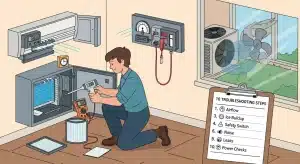
Las Vegas summers push air conditioners to their limits. When your AC falters—lack of airflow, ice buildup, odd sounds, or leaks—a swift, systematic approach can often restore comfort without waiting on a service call. Below, each of the 10 most common AC issues is expanded with practical DIY tips to help you diagnose the symptom, plus a link to our in-depth article for a full solution.
Airflow Problems: “My AC Isn’t Blowing Hard”
Why it matters: Restricted airflow makes your system work harder, raises energy bills, and can freeze coils.
Quick DIY Tips:
- Filter Check: Hold your filter up to a light—if it’s opaque, swap it for a fresh pleated MERV-13 unit. This simple step often restores 80% of lost airflow.
- Duct Inspection: Remove a supply register and shine a flashlight inside. Look for kinks, crushed flex duct, or debris blocking the path. Straightening ducts and clearing obstructions can immediately boost CFM.
- Damper & Register Adjustment: Ensure all dampers and vents are fully open. Furniture or rugs can inadvertently block returns—move them and feel the difference at the registers.
Want more detailed airflow diagnostics and sealing techniques? Read our full guide: AC Not Blowing Hard? Discover Causes Behind Low Airflow.
Frozen Coils: “Why Does My AC Keep Freezing Up?”
Why it matters: Ice on the coil stops cooling and can damage your compressor if left running.
Quick DIY Tips:
- Safe Thaw: Turn off cooling but leave the fan on for 2–4 hours to melt ice without chipping the coil. Chipping risks bent fins and refrigerant leaks.
- Filter & Blower Check: After thawing, replace the filter and set the thermostat to “Fan On.” If airflow remains weak, your blower motor or wheel may need cleaning or replacement.
- Refrigerant Clues: Frost patterns only on the suction line often indicate low refrigerant. Look for oily residue at joints—this is a sure sign you’ll need a certified technician.
For full thawing steps, freeze-prevention strategies, and professional triggers, see: Why Does My AC Keep Freezing Up?.
Outdoor Fan Motor Failures: “5 Signs Your AC Fan Motor Is Bad”
Why it matters: A non-spinning or noisy outdoor fan leads to overheating, high pressure, and compressor failure.
Quick DIY Tips:
- Debris Removal: Cut power, remove the cabinet panels, and clear leaves, dirt, or small critters obstructing the fan blades.
- Manual Spin Test: With power off, rotate the fan by hand. If it feels rough or sticks, the bearings are worn and the motor must be serviced.
- Voltage Check: Use a multimeter at the contactor to confirm 240VAC is reaching the motor. No voltage means an electrical control issue, not the fan itself.
Learn all five warning signs, amp-draw tests, and replacement procedures here: 5 Signs That Indicate Your AC Fan Motor Is Bad.
Indoor Blower Motors: “AC Blower Motor Repair & Replacement”
Why it matters: The indoor blower distributes cooled air; when it fails, you’ll feel nothing at your vents despite an otherwise functioning system.
Quick DIY Tips:
- Capacitor Test: A failing start capacitor often mimics a dead motor. After cutting power, test the capacitor’s microfarads against its nameplate value and replace if it’s more than ±6% off.
- Wheel Cleaning: Remove the blower wheel and vacuum away accumulated lint. Even a thin layer reduces air volume significantly.
- Safety Switch Check: Many furnaces include a blower-door safety switch. Ensure the access panel is fully seated so the switch can close and allow motor operation.
For a deeper dive into PSC vs. ECM motors, pricing, and step-by-step swap instructions, read: AC Blower Motor Replacement: 5 Signs It’s Time for HVAC Maintenance.
Odors & Mold: “Why Does My AC Smell Bad?”
Why it matters: Musty air often signals microbial growth, posing health risks and system corrosion.
Quick DIY Tips:
- Filter Swap: Install a fresh carbon-infused filter to trap VOCs and odors immediately.
- Drain Pan Flush: Pour ½ cup of white vinegar into the condensate line to kill algae and bacteria that cause sour or vinegar-like smells.
- UV-C Addition: Consider installing a UV-C lamp in the supply plenum to prevent mold regrowth on coils and surfaces.
For six odor profiles and targeted cures, see: Why Does My Air Conditioner Smell Bad?.
Loss of Cooling: “Why Isn’t My AC Cooling My Home?”
Why it matters: Running fans without cooling wastes energy and leaves you sweltering.
Quick DIY Tips:
- Thermostat Audit: Confirm it’s set to “Cool,” fan on “Auto,” and setpoint at least 5°F below room temperature.
- Condenser Clean: With power off, use a garden hose to rinse the outdoor coil fins—avoid electrical components. Dirty condenser coils can raise head pressure and kill cooling output.
- Refrigerant Signs: Look for frost on suction lines or oily residue—both indicators of a leak that requires EPA-certified service.
Dive into 10 root-cause checks, from pressure readings to duct leaks, in: Why Isn’t My Air Conditioner Cooling My Home Sufficiently?.
No-Power Issues: “AC Won’t Turn On? Electrical & Safety Checks”
Why it matters: A silent AC can be caused by simple breaker trips or serious electrical faults.
Quick DIY Tips:
- Breaker Reset: Flip both the indoor and outdoor AC breakers fully off, then back on. A stubborn trip suggests a short or overload.
- Disconnect Box: Ensure the outdoor service disconnect is in the “On” position and fuses are intact—replace blown fuses with exact amp-rating spares.
- Float Switch: Check the condensate pan for standing water. A tripped float switch will kill the blower to prevent overflow damage.
For a full electrical pathway map, safety-first advice, and voltage-check walkthrough, read: AC Won’t Turn On? Power & Safety Checks.
Unusual Noises: “Noisy Air Conditioner Fixes”
Why it matters: Sounds like buzzing or clanking often predict component failure—ignoring them can turn a $100 repair into a $2,000 disaster.
Quick DIY Tips:
- Loose Panel Screws: Turn off power and tighten exterior and blower-door screws—vibration-induced rattle is often just a missing screw.
- Debris Removal: Debris in the condenser or blower wheel creates pinging or thumping—clear it out and test for noise reduction.
- Lubrication: Some older motors have oil ports; apply a few drops of machine oil to accessible bearings.
For a detailed noise-to-cause matrix and advanced fixes, see: 5 Common Causes of a Noisy Air Conditioner.
Water Leaks & Drainage Problems
Why it matters: Standing water leads to mold, structural damage, and safety hazards.
Quick DIY Tips:
- Turn off power and remove the indoor unit’s front panel.
- Detach the 1″ condensate line and vacuum out algae or sludge with a wet/dry vac.
- Flush the line with 1 cup of vinegar or bleach solution, then rinse with clear water.
External Resource: EPA Indoor Air Quality Handbook
Landlord Lens: “AC Repair for Rental Properties in Las Vegas”
Why it matters: Under NRS 118A, landlords have 48 business hours to fix essential services—or face rent withholding, self-repair deductions, and legal action.
Quick Action Plan:
- Centralize maintenance requests in a portal with automated prioritization for “no-cool” emergencies.
- Vet 24/7 HVAC vendors for fast dispatch, flat-rate pricing, and clear warranties.
- Stock on-site parts (filters, capacitors, belts) to resolve up to 35% of calls on the first visit.
Build your full rental-property playbook—covering SLAs, tenant self-help, and compliance—in: AC Repair for Rental Properties in Las Vegas.
External Resource: Nevada Landlord-Tenant Statutes
Putting It All Together
Each of these ten sections addresses a distinct AC symptom or audience need. Use this guide as your troubleshooting index: perform the quick DIY steps, then click through to our specialized articles for detailed instructions, cost estimates, and professional boundaries. Whenever you encounter electrical hazards, refrigerant leaks, or mechanical failures beyond simple fixes, call the EPA-certified experts at The Cooling Company for AC Repair in Las Vegas. We’re available 24/7 at (702) 567-0707—your fastest path back to reliable, efficient cooling.



